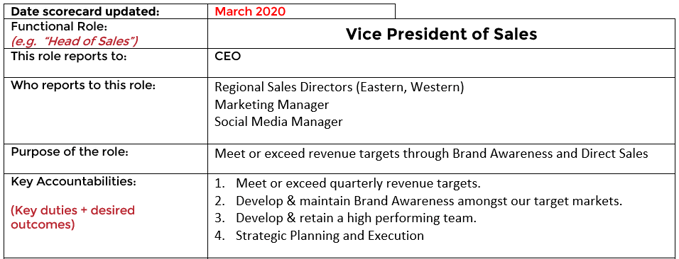Clarity
It is surprising how common this scenario is: a manager spends significant time and effort to recruit a highly talented employee, but somehow misses the importance of defining the role for that individual in terms of objective, measurable standards. We are not talking about job descriptions here - a typical job description describes the tasks and activities undertaken by the person in the role. Instead we should use a role-scorecard which objectively defines the measures of success for the role:

Accountability begins with clarity. High performers want unmistakable clarity of what it takes to be successful in their roles. These measures-of-success need to be objective and quantifiable. There can be no grey area. There should be a clear YES/NO answer to whether a target was met or not met.
Here is an example of a poorly defined statement performance statement:
- Provide outstanding customer support.
Although the sentiment is there, the definition is subjective. What does ‘outstanding’ mean? How is it defined and measured? Other words to be careful of are quality, timely, grow, provide, and so on.
A well-defined measure-of-success statement in a role’s scorecard might read something like this:
- Maintain customer support ticket close rate below 2.5 average days to closure with a 4.2-star ticket feedback score.
Defining success standards this way requires tracking. When roles are created or redesigned, leaders must ask the question, “what measures of success can be measured, or already are being measured?”
It may be necessary to create new measurement. For instance, in 2017 our marketing team decided that the size of our engaged community would be a key measure of brand awareness. Then they had to create a formula and tracking mechanism to measure it.
Role clarity plays a critical role in performance. Research undertaking by the Dutch talent analytics firm Effectory found that when employees have a clear understanding of the expectations they feel greater productivity and effectiveness, have a higher likelihood to stay with the company, and experience more satisfaction with management and leadership.
Progress
Seeing progress is another input that drives performance. Regular check-ins on performance, either between an individual and their manager, or in a group setting, is essential to keeping performance on track.

One organization we work with is Direct Tec, a provider of outsourced IT services. Each week Direct Tec’s CEO Stacy Adams chairs an all-hands meeting where team members gather around a dashboard and review the targets and results. In plain sight everyone can see the individual and collective performance on a variety of Key Performance Indicators (KPIs) – ticket resolution, client feedback, issue resolution duration, etc.
Using this data, the team and leaders can frequently celebrate successes, see trends, and identify places where individuals need help. It also creates healthy tension for individuals who want to do their part for overall team success.
“A personal choice to rise above one’s circumstances and demonstrate the ownership necessary for achieving desired results.”
-The Oz Principle
Visibility of performance is a key principle in accountability. Very few companies are good at setting and tracking KPIs at the organizational level, never mind for each employee.
In the book “Transforming Performance Measurement”, author Dean Spitzer describes the benefits of Key Performance Indicators. The use of KPIs…:
- Makes performance visible - You can only manage what you measure. Keeping the scores visible, where everyone can see them, shows you how well the various parts of the business are working, and who is performing and who is not.
- Improves execution - Larry Bossidy, co-author of the book Execution, remarked, “When I see companies that don’t execute, the chances are that they don’t measure.”
- Promotes consistency -Activities and outcomes that are not measured properly tend to fluctuate – with negative implications for the quality of your results.
- Improves decision making - One of the major causes of failure in decision making is poor use of data. One accurate measure can be worth a thousand opinions.
- Promotes understanding - Quality guru W. Edwards Deming said that systematic process measurement leads to the “profound knowledge” that is essential to top-quality outcomes.
Performance
As a leader, when it comes to accountability and performance, you get what you tolerate. If you tolerate an environment of obfuscation, blame, and lack of ownership, you will see those behaviors repeated. But if you take a stand that these behaviors are not acceptable, then you can stem the tide of poor performance. Depending on the extent of the existing performance issues, this may require some difficult and courageous conversations.
You also get what you model. You can’t expect others to display a high level of accountability if you don’t demand the same of yourself.
If you’d like to learn more about how to build a high performance company, or other ways you can take the simpler path to creating a great business, connect with us.




